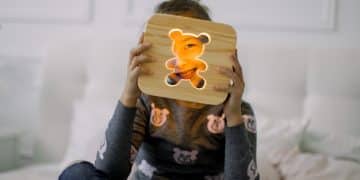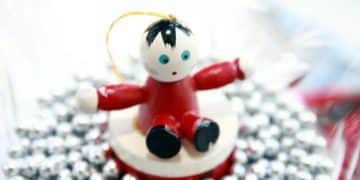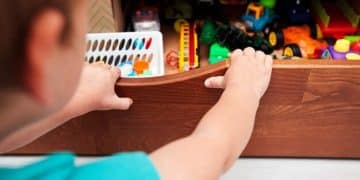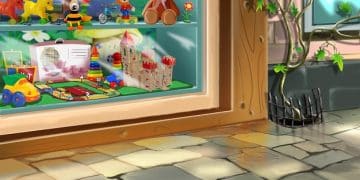Toy Testing Truth: 2025 Safety Standards Parents Must Know

The Truth About Toy Testing: What Parents Need to Know About Safety Standards in 2025 involves understanding evolving regulations, potential hazards, and proactive measures to ensure children’s safety when playing with toys.
Navigating the world of toy safety can be overwhelming for parents. Understanding the truth about toy testing: what parents need to know about safety standards in 2025 is crucial for protecting your children from potential hazards. Let’s explore what you need to know to make informed decisions.
Understanding Toy Safety Regulations in the US
Toy safety regulations in the United States are designed to protect children from potential harm. These regulations are continuously updated to address new hazards and technological advancements. Understanding the basics can help parents make informed choices.
Key Regulatory Bodies
Several organizations oversee and enforce toy safety standards in the US. Knowing their roles can help you navigate the complex landscape of toy safety.
The primary regulatory bodies include:
- Consumer Product Safety Commission (CPSC): The CPSC is responsible for ensuring the safety of thousands of consumer products, including toys.
- American Society for Testing and Materials (ASTM): ASTM develops voluntary safety standards that are often adopted by manufacturers.
- Toy Association: This industry trade group also promotes toy safety through various initiatives and resources.
The Role of ASTM F963
ASTM F963 is the standard consumer safety specification for toy safety. It covers various potential hazards, including:
- Small Parts: Toys with small parts that can be a choking hazard for children under three.
- Sharp Edges and Points: Toys with dangerous edges or points that can cause cuts or punctures.
- Flammability: Materials used in toys must meet certain flammability requirements.
Understanding the roles of these regulatory bodies and the specifics of ASTM F963 provides a solid foundation for assessing toy safety. It’s essential to stay informed as these standards evolve to address emerging safety concerns.
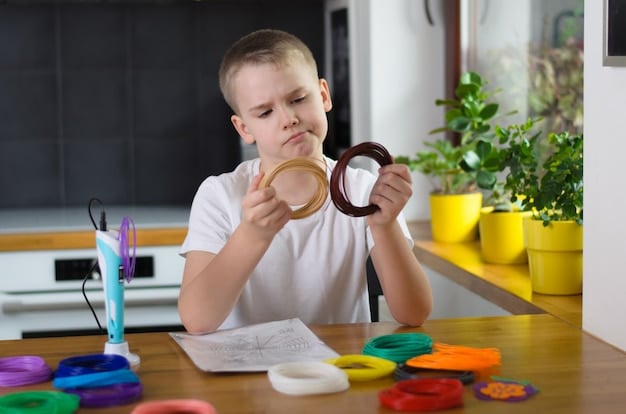
The Most Common Toy-Related Hazards in 2025
Even with regulations in place, certain hazards persist in the toy industry. Staying aware of these risks can help parents take proactive measures to protect their children.
Choking Hazards
Choking remains one of the most significant dangers, especially for young children. Toys with small parts or detachable components can easily become lodged in a child’s throat.
Chemical Exposure
Chemicals such as lead, phthalates, and BPA can be found in some toys. Exposure to these substances can lead to various health issues, including developmental problems and hormonal disruptions.
Physical Injuries
Toys with sharp edges, points, or projectiles can cause cuts, punctures, and eye injuries. It’s important to inspect toys regularly for any signs of damage that could lead to injury.
Being aware of these common hazards can help you make informed decisions when purchasing toys. Always supervise young children while they play and regularly inspect toys for wear and tear.
How Toy Testing Works: A Behind-the-Scenes Look
Toy testing is a rigorous process designed to identify and address potential safety hazards. Understanding this process can give parents confidence in the safety of the toys they purchase.
Types of Toy Testing
Toy testing can be categorized into several types, each focusing on different aspects of safety.
The primary types of testing include:
- Mechanical Testing: Evaluates the structural integrity of toys and their resistance to breakage.
- Chemical Testing: Checks for the presence of harmful chemicals such as lead, phthalates, and BPA.
- Flammability Testing: Assesses how easily a toy catches fire and how quickly it burns.
The Testing Process Step-by-Step
The toy testing process typically involves several steps:
- Sample Selection: A representative sample of the toy is selected for testing.
- Hazard Identification: Potential hazards are identified based on the toy’s design and materials.
- Testing: The toy undergoes various tests to assess its safety.
Ensuring Impartiality
To ensure impartiality, toy testing is often conducted by independent, third-party laboratories. These labs are accredited by organizations such as the CPSC and must adhere to strict quality control standards.
Understanding the toy testing process provides insight into the efforts made to ensure toy safety. By choosing toys from reputable manufacturers and looking for certifications from accredited labs, parents can feel more confident in their purchases.
What to Look for on Toy Labels in 2025
Toy labels provide important information about a toy’s safety and suitability for children. Learning to interpret these labels can help parents make informed purchasing decisions.
Age Recommendations
Age recommendations are based on the developmental abilities and safety concerns for different age groups. Always heed the manufacturer’s age recommendation, as it reflects potential hazards like small parts.
Warning Labels
Warning labels alert parents to specific hazards associated with the toy. Common warnings include choking hazards, strangulation risks, and the presence of small parts.
Critical things to consider in warning labels:
- Choking Hazards: Toys with small parts are often labeled as unsuitable for children under three.
- Supervision Required: Some toys require adult supervision due to potential safety risks.
- Allergens: Toys made with materials that may cause allergic reactions should be clearly labeled.
Certifications and Compliance Marks
Certifications and compliance marks indicate that a toy has been tested and meets safety standards. Look for marks such as the CE mark (for European standards) and the ASTM compliance mark (for US standards).
Understanding toy labels empowers you to make safer choices for your children. Always read labels carefully and consider the age, abilities, and potential risks before purchasing a toy.
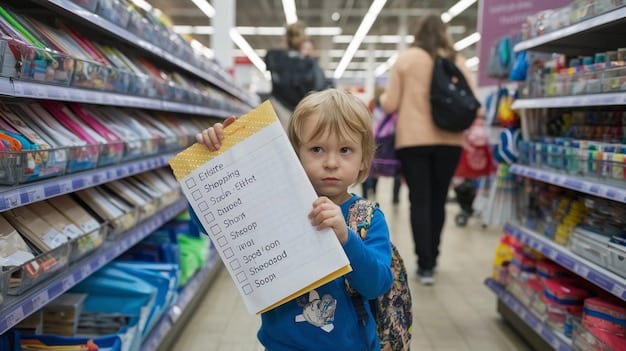
Emerging Toy Safety Issues in 2025
As technology evolves, so do the potential hazards associated with toys. Staying informed about emerging safety issues is essential for protecting children in 2025.
Smart Toys and Cybersecurity Risks
Smart toys, which connect to the internet and collect data, present unique cybersecurity risks. These toys can be vulnerable to hacking, data breaches, and privacy violations.
Battery Safety
Many modern toys rely on batteries, posing risks such as battery leakage, ingestion, and fire hazards. Always use the correct type of batteries and supervise children when they play with battery-operated toys.
The Rise of Counterfeit Toys
Counterfeit toys often bypass safety regulations and may contain harmful substances or design flaws. Purchase toys from reputable retailers to avoid counterfeit products.
Staying informed about emerging toy safety issues is crucial for parents. Advocate for stricter regulations, monitor your children’s toy use, and report any safety concerns to the appropriate authorities.
Practical Tips for Parents to Ensure Toy Safety
While regulations and testing play a crucial role, parents also have a responsibility to ensure toy safety in their homes. Here are some practical tips to help you protect your children.
Regular Inspections
Inspect toys regularly for signs of wear and tear, damage, or loose parts. Discard any toys that are broken or pose a safety hazard.
Proper Storage
Store toys in a safe place where children cannot access them without supervision. Keep small toys away from infants and toddlers.
Supervision During Playtime
Always supervise young children during playtime, especially when they are playing with toys that have small parts or potential hazards.
Easy steps on toy supervision:
- Be Present: Actively supervise children during playtime, especially with new or potentially hazardous toys.
- Teach Toy Safety: Educate children about toy safety, including the importance of not putting small parts in their mouths.
- Address Misuse: Correct any misuse of toys that could lead to injury.
Reporting Unsafe Toys
If you encounter a toy that you believe is unsafe, report it to the CPSC. Your report can help prevent other children from being injured.
By following these practical tips, you can create a safer play environment for your children. Remember, toy safety is an ongoing effort that requires vigilance and proactive measures.
| Key Point | Brief Description |
|---|---|
| ⚠️ Regulations | US toy safety regulations are crucial to protect children from potential harm. |
| 🧪 Hazards | Common hazards include choking risks, chemical exposure, and physical injuries. |
| 🧐 Labeling | Toy labels give information on age, warnings and certifications to consider. |
| 🛡️ Tips for Parents | Tips include regular inspections, proper storage, constant monitoring and reporting incidents. |
FAQ Section
▼
ASTM F963 is the standard consumer safety specification for toy safety. It addresses hazards like small parts, sharp edges, and flammability. These requirements ensure toys meet minimum safety standards.
▼
You can report an unsafe toy to the Consumer Product Safety Commission (CPSC). Visit their website or call their hotline to submit a report detailing the safety issue.
▼
Choking hazards typically include small parts, small balls, and balloons. Toys intended for older children can pose a risk to younger siblings, so keep them separated during play.
▼
On toy labels, look for age recommendations, warning labels (especially regarding choking hazards), and compliance marks like the ASTM compliance mark, and always read warnings carefully.
▼
Toy testing is vital because it identifies potential hazards such as chemical exposure and structural weaknesses. Testing ensures toys meet safety standards, protecting children from harm.
Conclusion
Understanding the truth about toy testing: what parents need to know about safety standards in 2025 is essential for protecting your children. By staying informed, inspecting toys regularly, and supervising playtime, parents can create a safer play environment and promote happy, healthy development.
